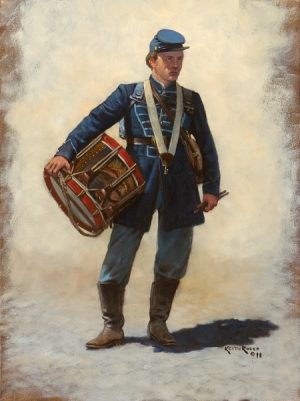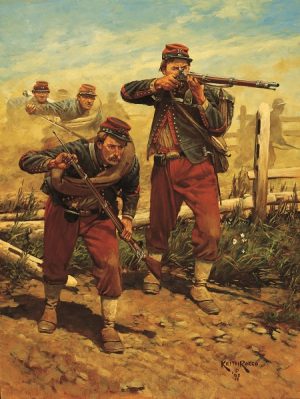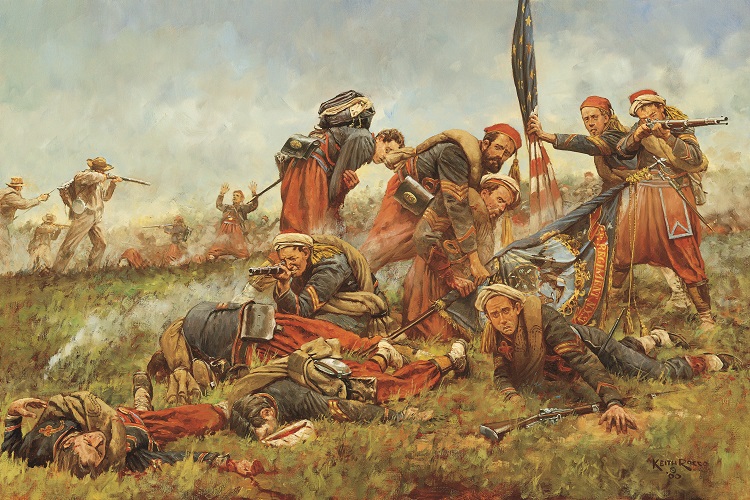Save the Colors
Description
500 signed and numbered prints
Much of Fitz Porter’s Union Corps was filtered from its’ morning position to assault ‘Stonewall’ Jackson’s force north of the Warrenton Pike but Colonel Gouverneur Warren’s 5th New York and 10th New York Zouaves, 1,100 men, remained in place.
Unwilling to believe the warnings of a Confederate presence south of the Warrenton Turnpike, Union commander John Pope fixated on the destruction of Jackson’s force and continued to strip his exposed left flank of troops. Just after 4 pm, disaster appeared on the Federal left in the form of General James Longstreet’s corps, 30,000 strong. Their first obstacle was the six companies of skirmishers from the 10th National Zouaves.
Rank after rank of Southern troops emerged from the cover of a wood line, and came sweeping across the fields like a vast gray wave. When they encountered the 10th New York skirmishers, the latter “fired one volley and fled closely pursued.”
The command “Attention, battalion!” brought the 5th New Yorkers to their feet, even as the first shots echoed from the woods in front. Suddenly, shadowy groups of running figures appeared, moving through the underbrush toward the Federal line. “Don’t fire! Those men belong to the Tenth!” The skirmishers were crowding back on their reserve companies, whose officers were frantically trying to form a line on the left of the 5th New York. Close on the heels of the scrambling Yankees came their assailants. Regardless of the New York men to their front, Colonel Warren and Captain Winslow of the 10th gave the command to commence firing. The Rebels responded at a range of less than 100 yards. Scores of Zouaves were scythed down where they stood, and the line wavered as bullets opened bloody gaps in their ranks. “Not only were men wounded, or killed, but they were riddled.” Private Frederick Fowler of Company B would have agreed. Simultaneously, four Minie bullets, a musket ball and a buckshot slammed into his body. One bullet passed through Fowler’s chest, puncturing his left lung and emerging from his back. He was shot through both thighs and both arms, two of the wounds fracturing bones, while a sixth shot traversed his left foot from toes to heel. One of Fowler’s comrades, Harry Greenwood, collapsed with a fractured skull. George Colwell, next to Greenwood, was shot through the right wrist; the force of the blow flung his arm up and back, breaking it at the elbow.
While the Hampton Legion and 18th Georgia struck Warren’s front and right, the 5th Texas partially overlapped the left flank, enfilading the reserve companies of the 10th New York and flaying the left wing of the 5th with a vicious cross-fire. Soon after the opening volley, the Zouaves began to unravel from left to right.
Recognizing the hopelessness of his brigade’s position, Colonel Warren determined to execute a fighting retreat before the line was entirely enveloped. But Warren’s orders to retire went unheard above the din.
As the line disintegrated, a knot of desperate men clustered around the regimental colors. Color Sergeant Andrew Allison, a British army veteran who carried the Stars and Stripes, was shot in the wrist. He passed the flag to another man and started for safety, but then turned back, retook the flag and was immediately shot dead. The banner was raised, shot down, and raised again. Ultimately Corporal Lucien B. Swain bore it’s bloody folds and splintered staff to safety.
The guardian of the blue regimental colors, 22-year-old, Irish-born Sergeant Francis Spelman, was shot in the left arm and fell to the ground. Two soldiers tried to get him off the field, but he spurned their aid and stood again, flag in hand. Moments later, a bullet ripped the length of his right arm to the shoulder and another shot tore through his neck. In desperate agony, Spelman cried out to Sergeant William Chambers, “For God’s sake don’t let them take my flag!” Chambers responded, and seized the flag from the stricken bearer. At that moment another bullet slammed into Spelman’s head, nearly severing his lower jaw from his face. All but one of the regimental color guard lay dead or dying, but the banners were saved.
The fight now became a hopeless butchery. With the Confederates blazing away at their backs, dozens of fleeing Zouaves were sent sprawling in the mad dash for Young’s Branch, or fell on the open slope that lay beyond the stream.
Only 60 Zouaves managed to rally around Colonel Warren and the bullet-torn colors, making their way to the Henry House plateau. Appalled by the sight of the pitiful remnant, an officer of the 5th U.S. Infantry wrote, “A murmur of surprise and horror passed through the ranks of our Regulars at the fate of this brave regiment.” In their 10 minutes at the vortex of hell, the 5th New York lost 332 men of the approximately 525 engaged. It was the greatest battle fatality sustained by any Federal infantry unit in the war.
EXCERPT FROM Brian Pohanka’s “The Very Vortex of Hell”, American’s Civil War, September 2002.
Edited with author’s permission
Additional information
| Medium | |
|---|---|
| Size | 20" x 30" |
| Type |
Related products
-

Marshall’s Crossroads
$285.00 – $345.00 Select options This product has multiple variants. The options may be chosen on the product page -

Federal Infantry Drummer
$125.00 Add to cart -

The 14th Brooklyn
$220.00 Add to cart -

Key to Corinth
$185.00 Add to cart

